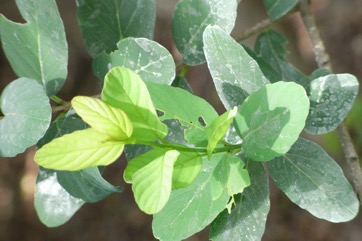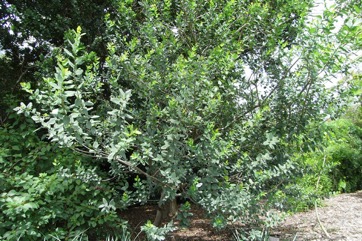Pink ivory, Red ivory

A tropical and subtropical plant. It grows on stony hillsides. It grows at medium and low altitudes in South Africa. It is drought resistant. It can only tolerate light frosts. It can grow in arid places.
Also known as:
Miumbeza, Mkwalo, Moonay, Muhukuma, Mulatchine, Munhei, Munikani, Munikara, M'naga, Munyii, Musukachuma, Muvhunambeza, Nkunzi, Pau-rosa, Rooi-ivoor, Sibeta, Sineyi, Tineyi, Umgologoti, Umncaga, Umneyi, Umnyiyi
Synonyms
- Rhamnus zeyheri Sond.
- Phyllogeiton zeyheri (Sond.) Suesseng
Edible Portion
- Fruit
Where does Pink ivory grow?
Found in: Africa, Botswana, East Africa, Eswatini, Malawi, Mozambique, Namibia, South Africa, Southern Africa, Swaziland, Zimbabwe
Notes: There are 12 Berchemia species.
Status: They are popular.
Growing Pink ivory, Red ivory
Cultivation: Plants can be grown from fresh seed. Ripe fruit are collected from a tree and the flesh removed then the seeds planted. Seeds germinate in 5-9 days. Seedlings can be transplanted at the 2 leaf stage.
Edible Uses: The fruit are eaten raw. The fruit are collected and stored in baskets where they form a solid brown sugary mass. They are dried and ground and used with grains for porridge. They can be used for jam, juice and sweets.
Production: Growth is slow.
Nutrition Info
per 100g edible portion| Edible Part | Energy (kcal) | Protein (g) | Iron (mg) | Vitamin A (ug) | Vitamin c (mg) | Zinc (mg) | % Water |
|---|---|---|---|---|---|---|---|
| Fruit | 89 | 1.1 | 1 | - | 6.5 | 0.3 | 76.3 |
Pink ivory, Red ivory Photos


References
Altschul, S.V.R., 1973, Drugs and Foods from Little-known Plants. Notes in Harvard University Herbaria. Harvard Univ. Press. Massachusetts. no. 2636 (As Rhamnus zeyheri)
Drummond, R. B., 1981, Common Trees of the Central Watershed Woodlands of Zimbabwe, National Herbarium Salisbury. p 134
Fox, F. W. & Young, M. E. N., 1982, Food from the Veld. Delta Books. p 313
Jardin, C., 1970, List of Foods Used In Africa, FAO Nutrition Information Document Series No 2.p 155 (As Phyllogeiton zeyheri) and p 157 (As Rhamnus zeyheri)
Long, C., 2005, Swaziland's Flora - siSwati names and Uses http://www.sntc.org.sz/flora/
Ogle & Grivetti, 1985,
Palgrave, K.C., 1996, Trees of Southern Africa. Struik Publishers. p 553
Palmer, E and Pitman, N., 1972, Trees of Southern Africa. Vol. 2. A.A. Balkema, Cape Town p 1399
Peters, C. R., O'Brien, E. M., and Drummond, R.B., 1992, Edible Wild plants of Sub-saharan Africa. Kew. p 165
Plowes, N. J. & Taylor, F. W., 1997, The Processing of Indigenous Fruits and other Wildfoods of Southern Africa. in Smartt, L. & Haq. (Eds) Domestication, Production and Utilization of New Crops. ICUC p 186
Royal Botanic Gardens, Kew (1999). Survey of Economic Plants for Arid and Semi-Arid Lands (SEPASAL) database. Published on the Internet; http://www.rbgkew.org.uk/ceb/sepasal/internet [Accessed 6th June 2011]
Ruiters-Welcome, A. K., 2019, Food plants of southern Africa. Ph.D. thesis. Univ. of Johannesburg p 93
Schmidt, E., Lotter, M., & McCleland, W., 2007, Trees and shrubs of Mpumalanga and Kruger National Park. Jacana Media p 378
Swaziland's Flora Database http://www.sntc.org.sz/flora
Tredgold, M.H., 1986, Food Plants of Zimbabwe. Mambo Press. p 86
Trudy Bot. Inst. Akad. Nauk S.S.S.R., Ser. 1, Fl. Sist. Vyssh. Rast. 8:374. 1949
van Wyk, Be, & Gericke, N., 2007, People's plants. A Guide to Useful Plants of Southern Africa. Briza. p 36
van Wyk, B, van Wyk, P, and van Wyk B., 2000, Photographic guide to Trees of Southern Africa. Briza. p 10,
van Wyk, B-E., 2011, The potential of South African plants in the development of new food and beverage products. South African Journal of Botany 77 (2011) 857–868
Venter, F & J., 2009, Making the most of Indigenous Trees. Briza. p 68
Wehmeyer, A. S, 1986, Edible Wild Plants of Southern Africa. Data on the Nutrient Contents of over 300 species
World Checklist of Useful Plant Species 2020. Royal Botanic Gardens, Kew
www.zimbabweflora.co.zw 2011